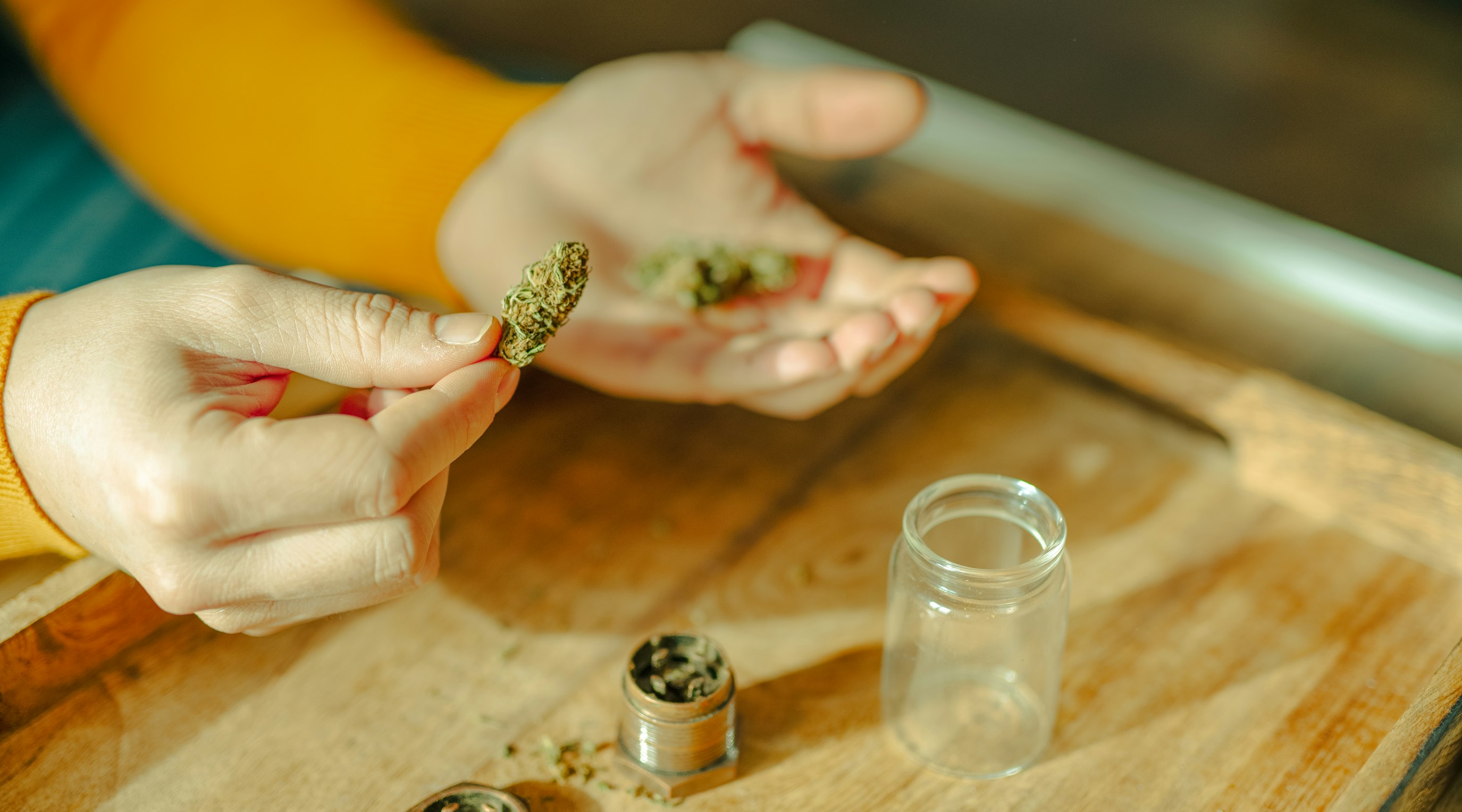CBD Dosage Guide UK: How much to take, how it works, and health benefits
15 min read
Lucy MacKinnon
CBD, or cannabidiol, is a non-intoxicating yet psychoactive compound (cannabinoid) found in medical cannabis and hemp.
Over the past few years, it has moved from the margins of alternative medicine into the mainstream, taken by patients across the UK to manage anxiety, chronic pain, sleep disorders, and other common conditions.
Typically, people new to CBD are unsure of how much CBD to take per day, however, most products do come with dosage recommendations. Experts often suggest increasing the recommended starting dose in 5 mg increments of CBD until the desired effect is reached.
This process, known as titration, allows you to gradually adjust based on how your body responds.
We’ve written this article to explain any questions you may have about how much CBD to take, or what precautions should be taken when you first start taking CBD. Here we go over the basics of CBD, establish the dos and don'ts of CBD dosing - but, as always, we recommend discussing your individual needs with your doctor or clinician to fully understand CBD oil.
And then there’s the CBD oil vs medical cannabis oil debate - a different conversation (but one that heavily overlaps) with medical cannabis oil offering more targeted, higher-strength formulations backed by specialist clinician supervision and a much higher level of regulatory oversight.
Contents
How is CBD used in the UK?
Despite its popularity, figuring out how much CBD to take and which type of product to use can feel like a bit of a mystery when you’re starting out. CBD oil, CBD gummies, CBD vapes and capsules all contain different amounts of cannabidiol, and your body won’t absorb each one in the same way.
Individual factors like body weight, metabolism and symptom severity all play a role in how CBD affects you therapeutically. What works well for one person might not work at all for someone else, which makes finding the right dose more about careful adjustment than fixed rules.
How CBD works in the body: Receptors, ECS and brain effects
Although CBD and THC share a similar chemical structure, made up of 21 carbon atoms, 30 hydrogen atoms and 2 oxygen atoms, their slight chemical differences are the reason for their differing effects on the human body.
Instead of binding directly to cannabinoid receptors to trigger responses, like THC does, CBD interacts with the endocannabinoid system indirectly.
New evidence suggests that CBD has very little direct affinity for either of the main cannabinoid receptors. Instead, it acts as an allosteric modulator, meaning it changes how those receptors respond to other molecules.
Instead of binding directly to its receptors, CBD appears to promote the longevity of the natural endocannabinoids that interact with a host of receptors by reducing their enzymatic breakdown.
Other receptors influenced by CBD: TRPV1, serotonin, and GABA-A
As well as being able to delay the uptake of naturally produced cannabinoids, CBD may also:
- Have the ability to mimic them to interact with their receptors. This includes TRPV1 receptors, which are known to influence inflammation and pain perception, as well as serotonin receptors, a type of G-coupled protein receptor that impacts anxiety, appetite, and addiction, and GRP55, which oversees the regulation of many physiological processes, including blood pressure and bone density.
- Much like Valium, CBD has also been shown to interact with GABA-A receptors, which may increase the binding affinity for neurotransmitters like GABA. This naturally promotes a calming effect, and this interaction has also been linked with the anticonvulsant and anxiolytic properties of CBD. In this case, cannabidiol is assumed to act as a positive allosteric modulator, altering the shape of these receptors in a way that enhances the effects of GABA.
- Scientists have also found that CBD may reduce some of the psychoactive or intoxicating effects of THC when the two are taken in combination. This could be because, instead of binding with CB1 receptors in the brain, cannabidiol has been shown to alter the shape of the CB1 receptor, reducing their binding affinity with THC, which in turn may reduce the likelihood of experiencing the euphoria or high associated with cannabis.
With the possible ability to influence many different neurotransmitters around the body, which trigger a wide variety of therapeutic results, it is no surprise that interest in CBD in medical treatment is rising.
Research potentially shows that patients living with sleep and skin disorders, and anxiety, as well as those with chronic pain, inflammation, and certain forms of epilepsy, could benefit from CBD treatments.
What personal factors affect CBD dosage?
Just like many other types of medications, CBD dosage sizes are tolerated quite differently depending on a range of factors.
Age, gender, and body weight can all influence a person's tolerance to cannabidiol, making their ideal dosages different. The severity of symptoms or conditions being treated with CBD also influences dosage recommendations.
Both CBD dosage charts and clinical prescribers often recommend taking CBD in a milligram to kilogram of body mass ratio - this is because body weight does impact how quickly the effects of CBD are felt, and potentially how long CBD stays in your body. Studies have also suggested that cannabis compounds affect men and women differently due to hormonal differences, though further research is still needed before clear recommendations can be made.
Extra safety is advised for seniors when calculating CBD doses, and some experts advise starting with an extremely low dose, such as 2.5 mg, or half the amount recommended by the product’s manufacturer, especially if the person is new to CBD. Seniors are often more sensitive to side effects, and the risk of interactions with other medications is higher due to common comorbidities. For this reason, checking in with a prescribing doctor is essential.
It's also important to remember that the type of CBD product you’re using can affect how your body responds.
There are three main CBD product types - Isolate CBD, full-spectrum CBD, and broad-spectrum CBD. Only
CBD isolate contains pure cannabidiol, while broad-spectrum and full-spectrum CBD products offer the CBD entourage effect as they include other compounds found in the cannabis plant, such as terpenes, flavonoids and, in the case of full-spectrum products, small amounts of THC (up to 1 mg of THC per product container). Even when the label shows the same CBD content, these different formulations can feel noticeably different in the body.
How much CBD should I take? Dosage guidelines and clinical data
CBD is well tolerated at a wide range of doses. While some clinical trials have tested doses as high as 1500 mg per day without serious side effects, most people take much less. Depending on the condition being treated, daily doses of CBD oil can range from as little as 5 mg to over 600 mg.
The right amount depends on the product, the person, and the intended effects.
CBD dosage examples from research and clinical trials
Low doses have also shown potential in other areas. In one study, just 5 mg of CBD appeared to reduce moderate pain within 20 minutes, while topical products have been explored for skin conditions due to their anti-inflammatory and antibacterial properties. Another study focusing on Bowel Disease noted that just 10 mg of CBD per day has the potential to reduce inflammation.
The anxiolytic, or anxiety-reducing, properties of CBD were displayed during a public speaking test when subjects were given 300 mg of CBD.
This study found that CBD dosed at a 300 mg/kg ratio may prevent Graft-Versus-Host Disease (GVHD) in transplant patients with acute leukaemia and other rare cancers. In the conclusion of this Phase 2 trial, researchers explained that in combination with standard GVHD treatment, CBD is a ‘safe and promising strategy to reduce the incidence of acute GVHD’.
A small-scale study investigated the effects of different CBD dosages on patients with Parkinson’s Disease. This study found that mild side effects were experienced at each dosing stage between 5 mg/kg and 25 mg/kg, however, the best-tolerated dose for Parkinson’s patients was 15 mg/kg. The study noted an improvement in nighttime sleep scores, emotional and behavioural dyscontrol, and a beneficial effect on total and motor MDS-UPDRS scores.
Although CBD is not believed to be toxic unless around 20,000 mg is taken in one day, it is still advisable to take the necessary precautions outlined in this article to avoid adverse reactions. If too much CBD is taken, or it interacts with other medications in the system, negative side effects can ensue. An increase in fatigue, a loss in appetite, and instances of diarrhoea have all been linked with inaccurate cannabidiol dosages, and so to avoid these it is important to calculate dosages carefully.
How to find the right CBD dosage for you
Once you’ve found a CBD product that you like, one that suits your needs and daily routine, the next step is working out how of it you actually need to take. Unfortunately, there is no universal formula - no magic chart that works for all of us.
Age, weight, tolerance, metabolism, and even hormone levels can all affect how CBD behaves in the body. This is why most clinicians recommend starting low and increasing slowly, adjusting as you go.
How do CBD product types affect dosage?
Some CBD products do provide their own dosage charts, and there are also a number of dosage calculators available online for those that don’t. Here you can input their personal data to have your ‘optimal dose’ of CBD calculated in milligrams, however, these tools are not always accurate.
For the best possible health results, you really can't go past seeking the advice of a doctor who is registered to prescribe medicinal cannabis, and one who has experience doing so for your particular health concern.
Not only do these doctors have the tools to accurately calculate ideal CBD dosages, but they are also able to provide an in-depth assessment of the potential side effects and interaction risks associated with taking cannabidiol.
Most CBD products are made from either broad-spectrum or full-spectrum extracts. These contain other compounds from the cannabis plant (like terpenes, flavonoids and a surprisingly wide range of minor cannabinoids) which can subtly shift how the product feels.
CBD is typically extracted using CO₂ or ethanol methods, both of which aim to preserve the cannabinoids and remove unwanted plant material. These methods can influence the purity and feel of the final product.
Texture, taste and absorption can also be influenced by things like which carrier oil is used, or any flavourings added.
Top CBD dosage tips for beginners
Learn the ABC’s of CBD
First, we’d recommend doing your research. Find out what kind of CBD product feels most comfortable to you, that could be easily incorporated into your daily routine, and best benefit your lifestyle.
We have a huge number of articles covering everything CBD (and medical cannabis). Click the search button at the top right of any Releaf page, type your search term, and you’ll be offered a bunch of education and blog articles, and glossary options.
Start low and go slow
Start small. See how your body reacts. Increase gradually. Rushing in with high doses is rarely helpful and can sometimes make it harder to judge what’s working.
Talk to your doctor
This matters more than many people realise.
CBD can interact with other medications, sometimes in subtle ways, sometimes more significantly. A doctor who knows your medical history and has experience prescribing medical cannabis is in the best position to guide you, especially if you're already taking prescriptions for conditions like thyroid imbalance, irregular heart rhythm or high blood pressure.
CBD dosage FAQs: Answers to common questions
How do I know if my dosage is right for me?
While there is no 'one size fits all' approach to CBD dosages, there are some rules you can apply to make sure you have the best chance at CBD success.
Everyone responds differently, and what works well for one person might simply not for you.
The best place to start is with a low dose, and then increase 5 mg per week until you begin to notice an effect. This process is known as titration, and when implemented correctly, reduces the risk of any noticeable side effects such as gastro upset or dizziness.
What is the recommended CBD dosage for depression?
Again, there is no one recommended dosage size for CBD. Some people report benefits from low to moderate daily use, but the research is still in the preliminary stages.
If you're considering CBD to support your mental health, it should be part of a holistic treatment strategy that might also include therapy, lifestyle changes and professional support. Start low, go slow, and speak to your doctor if you’re already on medication or have an existing diagnosis.
While not specifically on depression, a study from 2019 found that a multitude of mental health symptoms experienced by patients with Post-Traumatic Stress Disorder (PTSD) were seen to improve during an 8-week trial of CBD-based treatment, reporting a 28% overall reduction in PCL-5 scores.
PCL-5 scores are calculated by scoring the severity of PTSD symptoms including disturbed sleeping, unwanted memories, trouble experiencing positive emotions and reactions to stress.
What is the recommended CBD dosage for pain?
That depends on the type of pain and severity of symptoms.
- Mild Pain Relief: For those experiencing minor arthritis, manageable PMS symptoms, or low back pain, our meticulously formulated CBD oil offers a gentle yet effective solution. Start with a modest dosage and gradually increase it to achieve optimal relief.
- Moderate to Severe Pain: For those grappling with intense pain, such as severe arthritis, nerve pain, or persistent discomfort from conditions like multiple sclerosis or certain cancers, a higher dosage of CBD oil may be necessary. Begin this journey incrementally, starting with a moderate dose and adjusting as necessary to find your optimal relief.
- Chronic and Inflammatory Pain: Managing long-term inflammatory conditions like endometriosis or chronic cancer pain often requires a consistent, higher dose compared to acute pain. This dosage should be regularly monitored and adjusted in close consultation with a healthcare provider to ensure you receive the most effective relief.
Can medical cannabis products containing THC offer greater pain relief?
Yes, that's what the current research shows.
In the UK, medical cannabis was legalised in 2018. Private clinics like Releaf now offer prescriptions for products containing both CBD and THC, which can be especially useful for managing complex or long-term pain.
A 2017 study showed that patients with chronic pain who had tried both opioids and medical cannabis had a heavy preference towards medical cannabis. 92% said they preferred cannabis to opioids for treating their condition, and 93% said they’d be more likely to choose it if it were easier to access
Many patients report that whole-plant or full-spectrum formulations provide broader relief through a process known as the entourage effect, which is where multiple cannabis compounds (cannabinoids, terpenes, flavonoids) work together in the body.
Patients battling pain of all types may find greater relief from pain and a wider range of potential health benefits while taking cannabis-based medicines containing both THC and CBD than CBD oil alone.
Can I overdose on CBD?
No, at least not in the way that most people would describe as overdosing.
Another study from 2017 found that even when given incredibly high doses, up to 1,500 mg of CBD per day, patients showed no signs of serious side effects. However, it is still important to follow recommended dosages and consult with a healthcare provider if you have any concerns or experience any negative reactions while taking CBD.
Finding your ideal CBD dosage safely
When determining your ideal CBD dosage, we’d recommend following a simple set of rules, to maximise the plant's potential, whilst minimising the risk of side effects.
By seeking the advice of a doctor who has experience prescribing cannabis-based medications, you will be able to accurately calculate an ideal CBD dosage for your individual needs and lifestyle.
We also recommend taking the time to do your own research into what kind of CBD product best suits you, as well as starting with a low dose and gradually building up until desired effects are achieved. This will help you to experience the full potential of CBD, with minimal risk.
If you would like to learn more, or speak directly to a member of Releaf's world-class clinical team, head to our medical cannabis eligibility checker. It is free, takes less than 20 seconds to complete, and if you are approved, you will be prompted to create a Releaf account where you can then book your initial consultation.
Releaf - Let's rethink Healthcare
Share article
Did you like this article?
It is important to seek medical advice before starting any new treatments. The patient advisors at Releaf are available to provide expert advice and support. Alternatively, click here to book a consultation with one of our specialist doctors.
Elevate your wellness with medical cannabis
Get comprehensive care, convenience, and confidence with an all-in-one treatment plan.
Am I eligible?Authors
With five years of journalism and healthcare content creation under her belt, Lucy strives to improve medical cannabis awareness and access in the UK by producing high quality, credible content.
Editorial Policy
All of our articles are written by medical cannabis experts, guided by strict sourcing guidelines, and reference peer-reviewed studies and credible academic research. Our expert clinical team and compliance specialists provide valuable insights to ensure accuracy when required. Learn more in our editorial policy.
Need more help?










